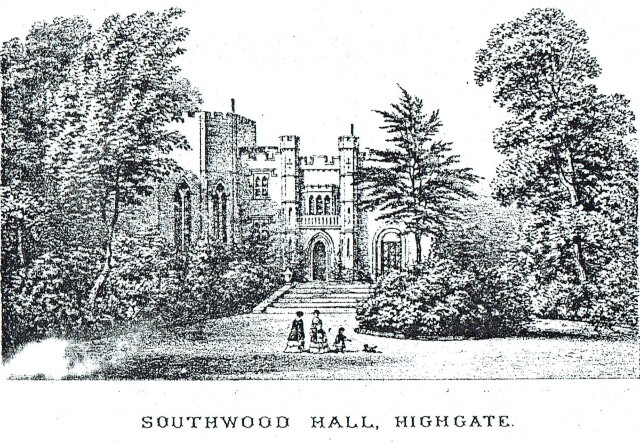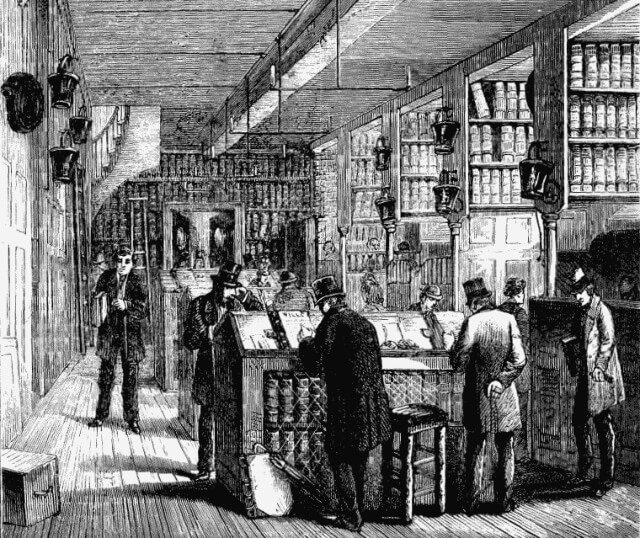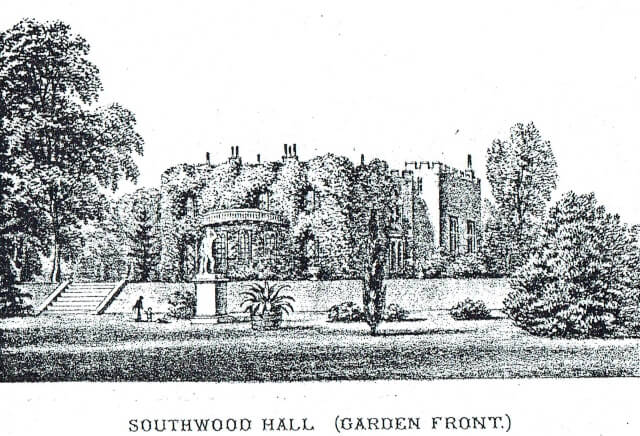We have previously looked at Southwood Hall in Highgate as part of the Lost Houses series and reference was made to two important 19th century occupants, Henry Virtue Tebbs and John Cathles Hill. This article focuses on the life of HV Tebbs (1797–1876).

Southwood Hall was a leasehold property owned by the heirs of Thomas Jones, husband of Laura, identified on the 1815 Hornsey Enclosure Map as owning the land with Ann Jaques. HV Tebbs and his family lived there between 1845 and 1861.
Early life
Henry Virtue Tebbs was born in Chelsea in 1797 to William Tebbs and his wife Mary (née Virtue). He was a serious and scholarly young man interested in literary pursuits and religion. He wrote hymns and poetry with the latter published privately in 1873 under the title, Fragments in verse and prose. These poems shine a light on his strong Christian faith, his devotion to his family, the Continental visits he undertook with Emma his wife, and on his time at Southwood Hall. The illustrations of Southwood Hall in this article are very similar to those in this book of poems.
His time as a lawyer
Tebbs was a solicitor, notary and Proctor in Doctors’ Commons. This was a complex of three types of law courts just south of St Paul’s Cathedral which operated from 1565 until 1858. Interestingly, Charles Dickens was a clerk at Doctor’s Commons in the early 1830s and made use of his experiences in his books. The lawyers who practised there were required to have doctorates in law from Oxford or Cambridge. Joan Schwitzer in her writings on Tebbs concluded that he was a Nonconformist, possibly a Moravian, but attendance at either Oxford or Cambridge points to him being a member of the Established Church (Anglican).

In 1822, aged 25 and unmarried, Tebbs published a blistering attack entitled, Essay on the Scripture Doctrines of Adultery and Divorce, and on the Criminal Character and Punishment of Adultery. Regardless of its pitfalls, Tebbs entered the state of holy matrimony in 1823 with Caroline Nailer. Tragedy struck with his young wife’s early death, possibly giving birth to their daughter Caroline in 1824.
Whilst practicing law in 1836-37, Tebbs acted for Mary Johnson, widow of Godscall Johnson, as trustee of the compensation money awarded her for enslaved people on the Holly and Savanna estates in Antigua. For £1000 Tebbs also bought the entitlement for the compensation of Catherine Carter for the enslaved people on the Haddons Estate in Jamaica.This makes very uncomfortable reading especially that the Antigua claim was contested by seven unsuccessful claimants and that Tebbs shared in a £2,450 13. 9d award made under the Slave Compensation Act 1837.
Religious tolerance
In 1830 Tebbs married for the second time. His bride, Emma Haslope, came from a Nonconformist family living in Highbury. Perhaps this led to Tebbs’ own encouragingly tolerant approach. He championed the rights of those who did not conform to the Established Church, whilst being a member of the Established Church himself, having a daughter who married an Anglican clergyman, a son, Stephen Nottidge, who took Holy Orders and a life-long correspondence with several Anglican clergymen.
Tebbs took the side of the Nonconformist managers of St Michael’s School, Highgate, when it was established in a new building on North Hill in 1852, and left the management board with them when the Vicar refused them admittance. He entertained Moravian Brethren who gathered at Southwood Hall for their annual meeting when missionaries reported on their overseas work, and he planted a Christmas tree in the garden at Southwood Hall for the benefit of a Moravian mission school.
Interest in youth
Tebbs took a special interest in education and youth clubs (he and Emma had six children) and he wrote a tract entitled, Address to the Young for the Formation of Juvenile Associations, as part of his efforts to bring Anglicans and Nonconformists closer together. He is credited with establishing the first Sunday School in Chelsea. He and Emma lived in Chelsea with their growing family until the move to Southwood Hall in 1845.
Five years later St James Church in Muswell Hill opened its new school in Fortis Green and Tebbs became one of the school managers alongside the Vicar, Rev James Browell, and other local ‘worthies’ of the area. He remained a manager until 1861, though he did not attend a management meeting after 1854, probably because of increasingly poor health. His memories of St James Church are expressed in the poem, On a Sunbeam, in the Church at Muswell Hill.

Love for Southwood Hall and estate
This was expressed through poems written when abroad during his bouts of ill-health and after his retirement from the law. He and Emma had known both joy and sadness at the house. The baby of the family, Theodore, was born there in 1848. In 1857 their daughter Anna Elizabeth died there, aged 19, after a lingering illness. She had asked to be buried in ‘a quiet churchyard’ and was interred at St John’s Church, Friern Barnet. The first poem in Fragments in verse and prose is about Southwood Hall. Below are two verses from it:
O pleasant Southwood! Half our wedded life
Was pass’d within thy walls;
And ev’ry line’ment upon thy face
Some fond delight recalls.Now these alone: the robin, blackbird, thrush,
Thy wooded shelter sought;
The crested wren, goldfinch, and nightingale,
Melodious music brought.
When returning from abroad in the 1860s-1870s, often from Pegli, outside Genoa Italy, which Tebbs called ‘a pleasant winter home’ and where he established a church for the English community, they lived at locations in the West Country, settling eventually at ‘Hillside’ in the village of Henbury, near Bristol. According to Ancestry UK records, Henry Virtue Tebbs, aged 79, was buried on 26 November 1876 in Henbury’s churchyard. It seems likely that the Tebbs’ had either recently returned from Pegli or had died there and his body brought home. Emma stayed on at ‘Hillside’ where she died on Christmas Day 1904, aged 93. Just a few days previously their son, Rev. Stephen Nottidge Tebbs, had also died at ‘Hillside’ and was buried in the same grave.
Image credits
The Prerogative Office, Doctors’ Commons – Wikimedia Commons,
Southwood Hall – HHS